The great guide to choosing knives
Knives – and multi-tools in general – come in many variations, variants and forms on the market. But how do you get to know the wide range and how to choose the right knife that will exactly meet your needs? First of all, you have to answer the question of what you expect from the knife and what is your priority. You buy another knife for the kitchen for deboning, another as a reliable survival knife and another as part of the basic equipment of your ultralight backpack.
Basic division of knives
Basically, we divide knives into:
- pocket and folding knives,
- fixed blade knives,
- possibly also various specials, e.g. for rescuers or for wood carving.
No knife is completely without compromises when performing various activities. If such existed, only one and only one would be produced – a perfect and universal knife. This is also why many professional and hobby users prefer multiple knives for different purposes. However, if you specify well in advance what you will primarily need your knife for, you may need just one for all of your outdoor activities.

Many professional and hobby users prefer multiple knives for different purposes. The ANV M200 HT fixed blade knife will serve as a tactical knife, but also a knife for outdoor activities.
Pocket and folding knives
Pocket knives are equipped with a closing blade, so they are very compact when carried (they do not take up much space in a backpack or pocket) and at the same time there is no risk of cutting yourself when they are closed. Such knives are suitable for travel as well as for the home, as they can work without problems in most common situations that you will encounter in life.
However, pocket knives have at least one disadvantage compared to knives with fixed blades. They do not have such a perfectly balanced center of gravity, and ergonomics are usually not their strong point either. In addition, they have a more complex design, which also means an increased probability that sooner or later something will go wrong with them – mostly due to neglected maintenance.
It is also really important to make sure that you only close a knife with a perfectly clean and dry blade. In addition, some mechanical safety devices today are almost as complex as a clockwork. And they are similarly difficult to repair.
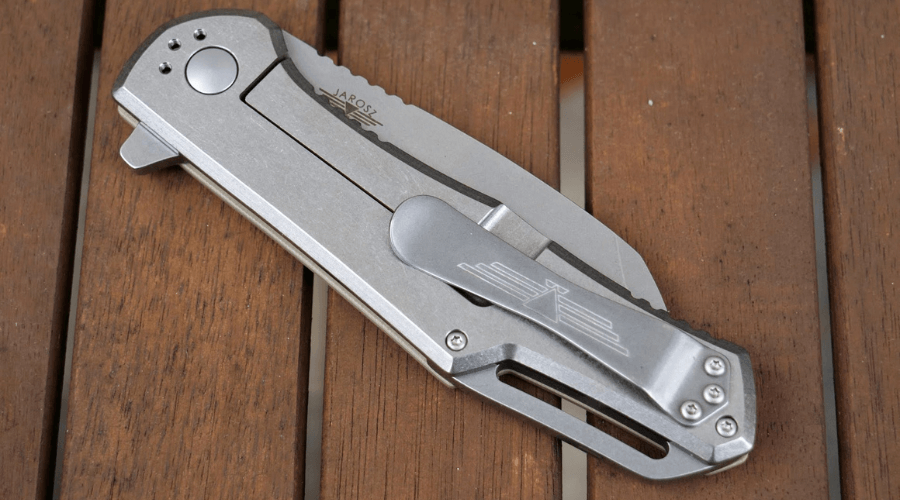
The folding knives are compact and suitable, for example, for travelling. The KA-BAR Jarosz Wharncliffe knife was created in collaboration with the experienced knifemaker Jess Jarosz.
Special types of folding knives
We can divide the folding knives even further, while the criterion is usually the method of handling the knife safety. A special type can be the butterfly knife, or balisong, which is most widespread in the Philippines and in the Czech Republic, unlike most Western countries, its carrying and use is allowed. Balisongs are primarily intended for self-defense purposes.
Another type of folding knife is the flipper, which you put into working readiness with a single press. Again, it is suitable for self-defense, for which it is very effective.
We also have knives with a thumb pin and an opening hook, which are mechanisms that are easy to operate and at the same time safe for the user. The classic opening is suitable for knives that do not need to be kept ready. You will need two hands to open them and use them during normal outdoor activities.
Pros of folding knives:
+ more compact design
+ safety device to reduce the risk of cuts
+ often lighter
+ suitable for normal everyday use
Cons:
- worse center of gravity
- worse ergonomics
- more complicated maintenance
- a more complex mechanism
- higher need to take care of cleanliness
Fixed blade knives
Knives with a fixed blade are a proven classic. They are more ergonomic and better balanced than pocket knives, and they are also easier to clean. On the other hand, they tend to be a bit heavier and bulkier, so they are not so easy to store. In addition, they require a special sheath for safe carrying, which should be tailor-made for a specific model.
The handle of such a knife generally holds better in the hand and the grip is therefore more stable. Traditional foresters swear by knives with a fixed blade. You can handle more demanding activities with them and you can also use them as hunting knives or knives in general for nature and for survival and bushcraft activities. With such a knife, you can disembowel a hunted animal, build an improvised shelter, cut paracord, confront an aggressive attacker or cut bread.
When choosing a knife with a fixed blade, you will be mainly interested in the length and shape of the blade, as well as the shape of the handle. However, the vast majority of knives today are manufactured with an ergonomic handle and a universal grip for both right- and left-handed users. And then there are special handles for one of these groups.
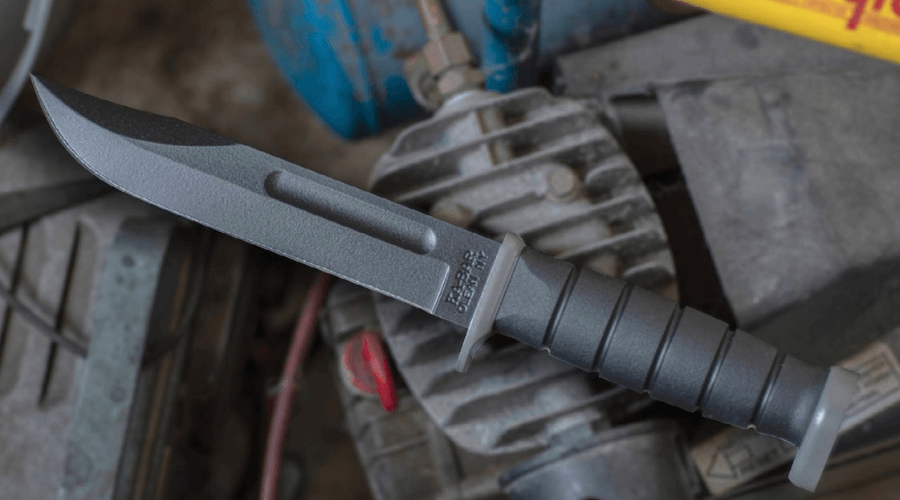
One of the advantages of a fixed blade knife is a more stable grip. The Short knife from KA-BAR, for example, is equipped with an ergonomic handle with anti-slip treatment and a double-sided guard.
Pros of fixed blade knives:
+ more ergonomic handle
+ more stable grip
+ more versatile possibilities of use
+ even for more demanding tasks
Cons:
- they are more difficult to transport
- must be carried in a sheath
- more likely to be cut if used carelessly
Another ways of dividing knives
There are other ways of dividing knives – knives can be distinguished by the shape of the shank (so-called tang), by the shape of the blade or by the type of sharpening (grinding). So let's take a brief look at the individual options.
Division of knives according to the shape of the shank
The tang, or shank, is the part of the blade that is not normally visible because it is hidden behind the handle. There are a total of seven basic options here, with the most reliable and durable being the full tang design, as the tang here reaches all the way to the end of the handle. A subgroup of the full tang is the so-called extended tang. And then we have half tang, skeletonized tang, push tang, rat tail tang, stick tang and encapsulated tang. You can read about the differences between them here.
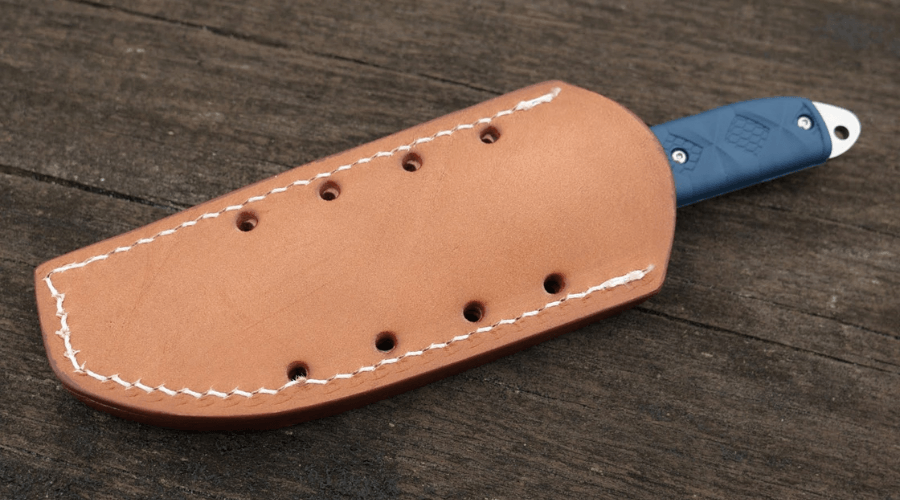
A knife with a fixed blade requires a quality carrying sheath. The Boss model from KA-BAR comes in a set with a quality leather sheath.
Division of knives according to the shape of the blade
Another option is to divide knives according to the shape of the blade. The basic and most common type is a knife with a belly-shaped blade, but we can also meet a needle-shaped (spear) blade or a tanto blade with a seemingly bitten tip. The shape of the blade is a special chapter, and the advantages of each variant can often be found in the descriptions of the individual knives that we offer at Rigad.
Just one small note on the subject – while the blade may be spear-shaped, most knives with it are not designed for throwing. If you want to use the knife as a javelin or spear, get a knife specifically characterized as a throwing knife. Unlike other types of knives, this one is made of softer steel, which is more resilient and not as prone to breaking as the harder steel that standard knives are made of. For the same reason, do not use a knife as a crowbar or hatchet.
Division of knives according to the type of grinding
The next chapter is the type of grinding, which is basically how the knife blade is sharpened. Again, we have a few basic types, some more common than others. And each of them has a slightly different purpose. The most commonly used grinds (cuts) include the flat or hollow grind, roughly in the middle are the Scandinavian (scandi) or sabre grinds, on the other hand, one-sided or convex grinds are relatively rare. If you are interested in this topic, you can read more about the types of grinding in this article.
Blade material
Let's stop for a moment at the material of the blade, which in the vast majority of cases is stainless steel. But we also know several types of stainless steel, and each type is suitable for something else. So that the choice is not so simple and unambiguous. The degree of "rustlessness" of the steel determines the proportion of chromium in it. The greater the proportion of chromium, the less prone it is to corrosion.
But also the higher the proportion of chrome, the worse the properties and durability of the blade. So it's always something in exchange for something else. With a lower proportion of chromium, on the other hand, the knife gets rusty faster and thus needs to be given more thorough care in terms of drying and cleaning, or oiling the blade. Carbon steel, on the other hand, has better properties in terms of durability. And it is better to create a spark with it in combination with flint, which every enthusiast of survival activities will confirm.
For steel, the degree of hardness HRC is given, while the higher the hardness, the longer the blade lasts and the better the knife cuts. But the disadvantage is the higher fragility of the knife, which is prone to breaking (see above) and harder steel is harder to sharpen. However, hardness and corrosion resistance are two different parameters that are mutually independent. Therefore, it is possible to meet carbon soft, carbon hard, stainless steel soft and stainless steel hard knives.
Handle material
We can also choose the knife according to the material of the handle or the hilt. While earlier manufacturers were limited to leather, metal and wood, nowadays they have much wider options, thanks to various plastic or polymer materials and their constant development.
As for wood, although it is beautiful and traditional, manufacturers are reaching for it less and less. Wood binds moisture in the air and because of this it can warp in various ways over time. Of course, there are various types of surface treatment of wood, which, however, can at least slow down the binding of atmospheric moisture, but never completely stop it.
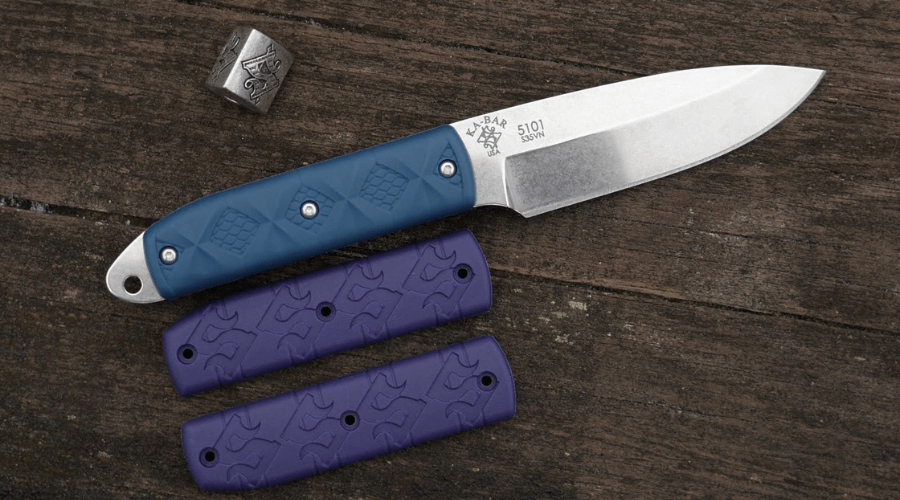
Nowadays, there is a wide selection of materials for handles. Some models have a special surface treatment for easier handling. Some models, such as Boss by KA-BAR, have easily replaceable handles.
Then we have plastics, which are relatively cheap to produce, but in some cases they can also feel cheap. Plastics are light, so when making a knife with a plastic handle, you need to pay attention to the correct location of the center of gravity, and at the same time they are also waterproof. Modern polymers have coped well with the disadvantages of cheaper plastics, such as a slippery surface. Plastic materials can be molded well, so there are practically no limits to design and texture.
The purely rubber handles mean an excellent grip and water resistance – on the other hand, resistance to mechanical influences is not great here. Aluminum and metal handles are very durable and usually look good, but on the other hand, they can slide and feel cold on your fingers in the winter.
Special category – multitools with knives
We can also meet a special category where the knife is part of a multifunctional tool or multitool. Such a multitool is useful if you have a particular idea of how it can be useful to you and if you are going to work on more demanding, specific tasks in the field. Naturally, you can also choose a multitool that is focused specifically on a certain type of activity – for example, cycling, fishing and the like. If you are engaged in such an activity, it is almost certain that you will use such a multitool at least from time to time.
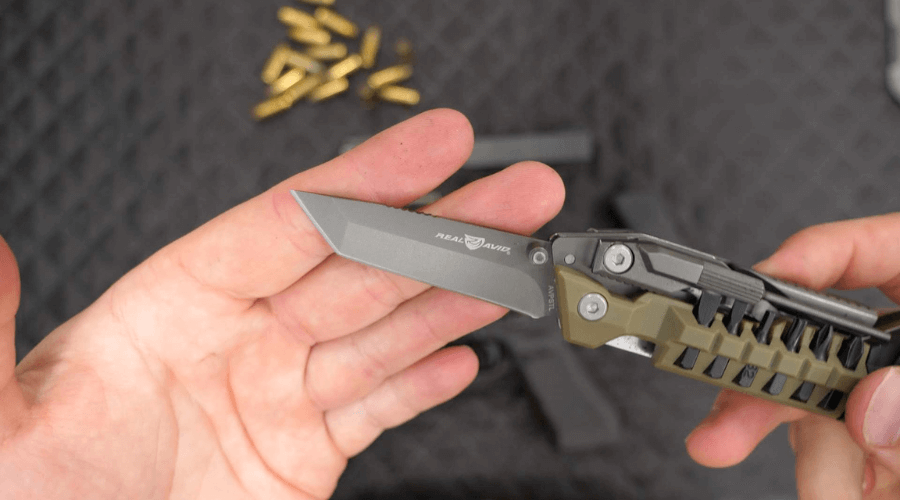
Some multitools have a specialized set of tools designed for different activities. Real Avid's multitool is designed for gun maintenance and adjustment.
Miniature multitools fit comfortably on keys, then there is a middle ground in the form of pocket multitools, which are more ergonomic and at the same time not as heavy as the largest models, which you can, on the other hand, easily pack in your car. However, multitools have much shorter blades on their integrated knives than most folding knives and fixed-blade knives. Therefore, they can serve you in an emergency as a knife replacement, but they are not suitable for larger jobs.
Readers are further interested

























































































































